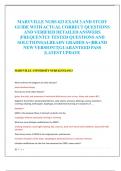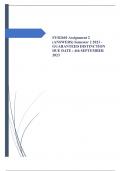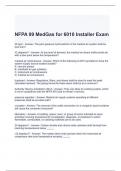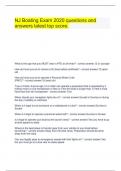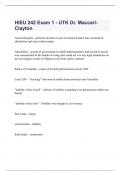MARYVILLE NURS 623 EXAM 3 AND STUDY
GUIDE WITH ACTUAL CORRECT QUESTIONS
AND VERIFIED DETAILED ANSWERS
|FREQUENTLY TESTED QUESTIONS AND
SOLUTIONS|ALREADY GRADED A+|BRAND
NEW VERSION!!!|GUARANTEED PASS
|LATEST UPDATE
MARYVILLE UNIVERSITY NURS 623 EXAM 3
What confirms the diagnosis of celiac disease?
distal duodenal biopsy
How do you treat celiac disease?
gluten free diet, and treatment of nutritional deficiencies such as iron, folate and vitamin B12
Epigastric discomfort, postprandial fullness, early satiety, anorexia, belching, nausea, heartburn,
vomiting, bloating, borborygmi, dysphagia, and abdominal burning are symptoms of .....
dyspepsia
GERD is the backward flow of stomach contents into the
esophagus without associated retching or vomiting
What are some lifestyle modifications for GERD?
smoking cessation, avoid tight clothing, diet, exercise, dont eat 4 hours before bedtime, sleep with HOB
elevated
The primary cause of GERD is the inappropriate, spontaneous
transient relaxation of the lower espophageal sphincter(LES) to an unknown stimulus
Lifestyle modification are the first line treatment for GERD, name some??
1|Page
,elevating HOB, avoid large, high fat meals, avoid chocolate, alcohol, peppermint, caffeine, onions garlic,
citrus and tomatoes; avoid lying down 3-4 hours after meal, avoid bedtime snacks, weightloss
If lifestyle modifications dont work in the treatment of GERD what is the first "step up" treatment with
non erosive reflux?
"tidine" :cimetidine, ranitidine, famotidine, nizatidine; if no improvement then PPIs are used
What is the initial therapy for patients with GERD who have erosive esophagitis or barretts esophagus
PPI's (razole) such as omeprazole once a day 30 minutes before breakfast (8 week course)
For a patient with GERD and complications such as erosive esophagitis or barretts esophagus who is
unresponsive to treatments what would your plan of action be ?
surgical intervention: nissen fundoplication
GERD is a lifelong disease and patients should be evaluated on a regular basis , patients with mild to
moderate symptoms should be instructed to treat how?
lifestyle modifications and antacids or OTC H2-RAs (famotidine) for 4 weeks;
What are the lifestyle modifications for GERD?
elevate HOB, no eating 3-4 hour before bed and no snacks, weight reducation, smoking cessation, avoid
large meals, tight clothing , avoid bending or straining, advise to eat small frequent meals
What are the most common causes of gasteroenteritis?
bacterial, viral and parasitic
A stool culture should be done on any patient who has what symptoms?
severe diarrhea, fever >101.3, bloody stools, leukocytes, lactoferrin or occult blood bc there are
indications of a bacterial pathogen
Any patient who develops diarrhea after initiation or completion of antibiotics therapy should have a
.......
tissue culture assay or an ELISA test for possible C-Diff
Viral gastroenteritis should be suspected in any patient with ____ as their major symptoms
vomiting; and in cases of possible food or water contamination
All patients who present with diarrhea should be treated with
fluid and electrolyte management; patients who can take oral replacement should be instructed to
drink fluids with a sodium content 45-75 meq (pedialyte or gatorade)
Patients with diarrhea require a diet that includes calories that come from
boiled starches and cereals (potatoes, rice, pasta wheat and oats), with the addition of salt
Patients with febrile dysentery should not receive anti- motility medications, why?
2|Page
,because slowing the intraluminal time may prolong the duration of the disease
How would you treat travelers diarrhea?
with trimethoprim-sulfamethoxazole (bactrim DS); one double strength tablet twice a day for 3 days
what is the drug of choice for afebrile nondysenteric cases of acute diarrhea?
loperamide (Imodium)
What would a break in the surface mucosa of the stomach or duodenum, which results when there is a
disruption of the normal mucosal defenses and the tissue is exposed to the damaging effects of acid by
pepsin>
peptic ulcer disease (gastric and duodenal ulcers)
What are the 3 major causes of PUD?
infection with H-pylori, chronic ingestion of ASA or other NSAID, acid hyper-secretion such as Zollinger-
Ellison syndrome
Caffeine, alcohol, and spicy food are no longer considered to be a risk for what disease ?
no longer considered ulcerogenic, PUD
Cigarette smoking, ASA, NSAIDs, and the bacteria Hpylori have been linked to ?
PUD
The hallmark of PUD is ?
complaint of burning or gnawing hunger sensation or pain (dyspepsia) in the epigastrium which is often
relieved by foods or antacids
A patient comes in complaining of epigastric pain that clusters and last for minutes with episodes
separated by periods of no symptoms, what would you suspect?
PUD
The diagnostic standard for PUD is what?
upper endoscopy
Zollinger-Ellison syndrome should be suspected in patients whos fasting serum gastrin level is above ___
and who have a basal acid output of more than ___?
serum gastrin level 600, basal acid output 15
What is the drug of choice for treating PUD?
PPI (prazole) omeprazole
When treating a patient with PUD if the patient has mild symptoms and no indications of complications
or a more serious disease, empiric therapy with an .....
3|Page
, H2-RA should be instituted for 2 weeks
When treating PUD with H2 receptor antagonist how would you administer?
once a day at bedtime or 1/2 the dose twice a day for 8 weeks
Antacids that contain ____ should not be used in patients with PUD; it can causes rebound acid
secretion.
calcium
What should you warn patients about when taking Bismuth for the treatment of PUD
Bismuth causes feces to darken or turn black; it can also cause hypoglycemia with antidiabetic
medications
What drug promotes ulcer health by stimulating mucosal bicarbonate and prostaglandin production ?
Bismuth preparations
If a patient is taking sucralfate in conjuction with an antacid , PPI, or H2-RA what should you teach
them?
sucralfate cannot be taken at the same time as the other medications or at the same time as digoxin,
cipro, or phenytoin
What therapy has shown to be effective in the eradication of H-pylori?
triple drug therapy, 2 antibiotics (clarithromycin and either amoxicillin or metronidazole) and a PPI
Cholecystitis is an acute inflammation of the?
gallbladder wall, which is usually the result of an impacted calculus within the cystic duct causing
inflammation proximal to the obstruction
A patient comes in with severe pain and tenderness in the epigastrium or RUQ area, this pain is
accompanied by nausea, vomiting, fever and leukocytosis, what would you suspect ???
cholecystitis
What are the signs and symptoms of cholecystitis?
severe pain and tenderness in the epigastrium or RUQ area, accompanied by nausea, vomiting, fever
and leukocytosis
What is the most common form of stone that occurs from cholecystitis??
cholesterol stones
What is cholelithiasis ?
gall stones
A patient complains of acute colicky type pain what would you suspect ?
4|Page

